B4.2: Ecological Niches | IB Biology HL
1/25
Earn XP
Description and Tags
Specialized nutrition to living organisms, Niches, adaptations
Name | Mastery | Learn | Test | Matching | Spaced |
|---|
No study sessions yet.
26 Terms
Define a niche.
B4.2.1: Ecological niche as the role of a species in an ecosystem.
The unique role that a species plays in the community
Like its habitat + occupation
State factors that determine the niche of a species.
B4.2.1: Ecological niche as the role of a species in an ecosystem.
Biotic and abiotic factors determine the niche of a species, including its growth, survival and reproduction, and how a species obtains food.
Biotic factors (living) include feeding relationships, provision of shelter, and parasites.
Abiotic factors (non-living) include water, sunlight, soil type, pH, and temperature.
Define tolerance.
B4.2.2: Differences between organisms that are obligate anaerobes, facultative anaerobes and obligate anaerobes.
How well a species reacts to the presence of something in its environment.
Compare the different oxygen requirements of obligate anaerobes, facultative anaerobes and obligate aerobes.
B4.2.2: Differences between organisms that are obligate anaerobes, facultative anaerobes and obligate anaerobes.
Obligate anaerobes cannot survive in the presence of oxygen. They can only (are obliged to) perform anaerobic respiration. They will die in the presence of oxygen, so they typically live in places where there is no oxygen (like deep soil, water, or the intestines of animals).
Facultative anaerobes can survive both in the presence and absence of oxygen. They can perform both aerobic and anaerobic respiration. They are neither hurt nor killed by oxygen. E.g. Baker’s yeast (Saccharomyces cerevisiae)
Obligate aerobes can only survive in the presence of oxygen. They can only perform aerobic respiration, so they will die in the absence of oxygen — such as during hypoxia (greatly reduced oxygen) or anoxia (absent oxygen). E.g. freshwater fish like trout
State the energy and carbon sources utilized in photosynthesis.
B4.2.3: Photosynthesis as the mode of nutrition in plants, algae, and several groups of photosynthetic prokaryotes.
Carbon dioxide and water are used as carbon sources. Sunlight is used as the energy source.

List three groups of photosynthetic autotrophs.
B4.2.3: Photosynthesis as the mode of nutrition in plants, algae, and several groups of photosynthetic prokaryotes.
Plants
Algae
Bacteria
Outline the acquisition of energy and matter through holozoic nutrition.
B4.2.4: Holozoic nutrition in animals.
Holozoic nutrition is a form of heterotrophic nutrition where an organism acquires energy and matter by ingesting, digesting, absorbing, and assimilating nutrients from food.
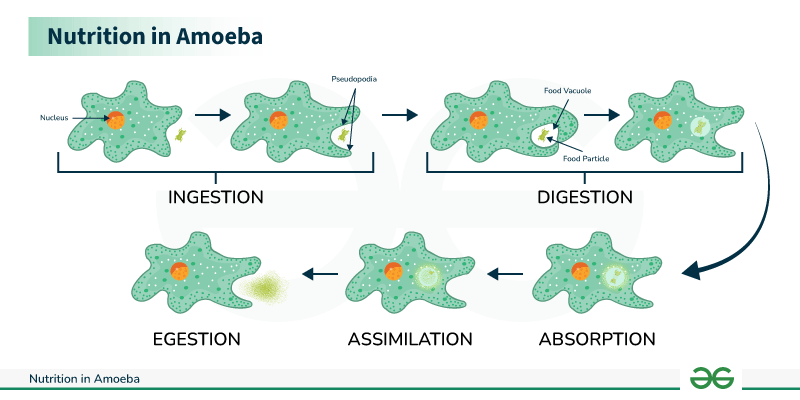
Compare autotrophs and heterotrophs.
B4.2.4: Holozoic nutrition in animals.
Autotrophs produce their own food, while heterotrophs must take food from other organisms for energy and matter because they cannot make their own food.
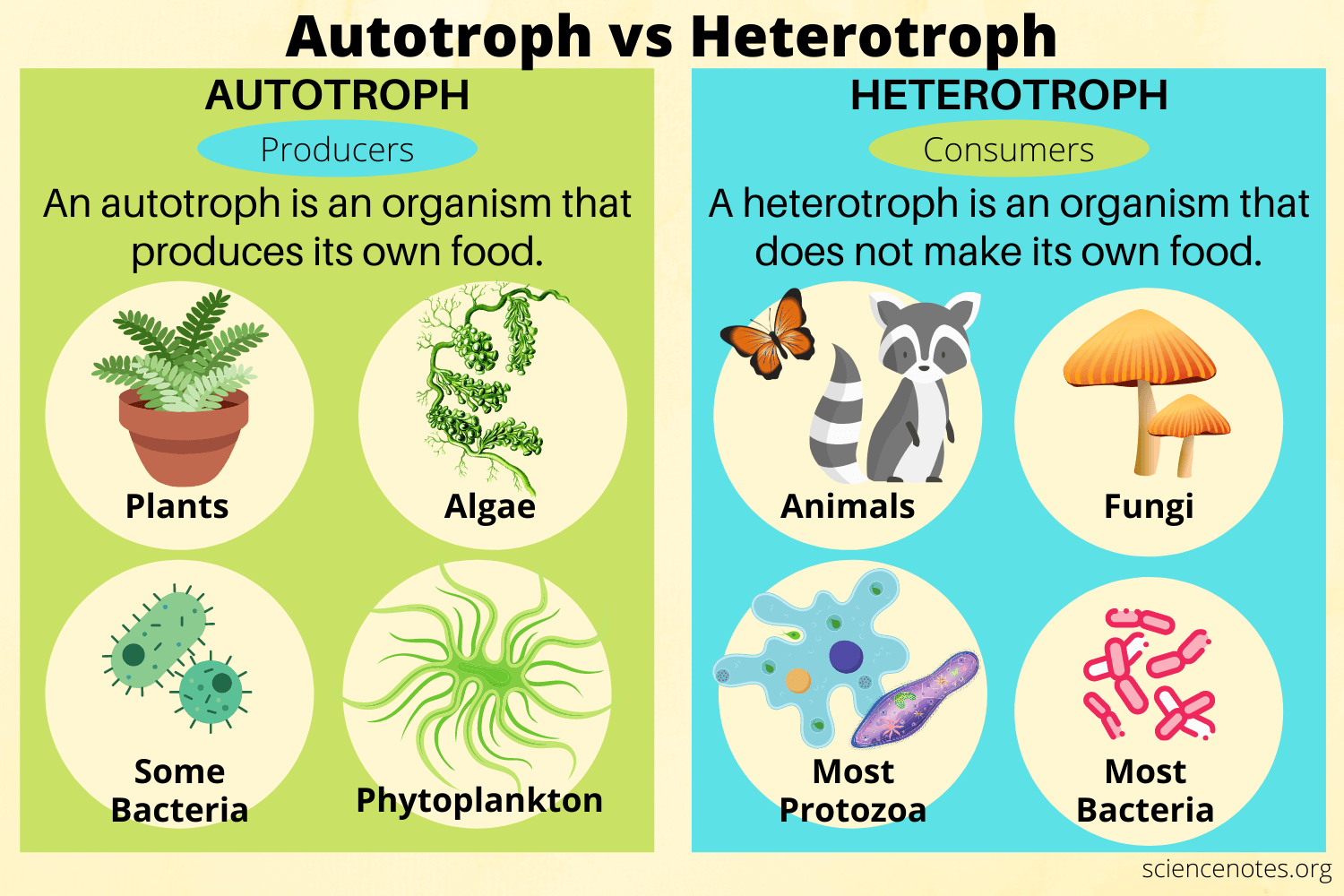
Distinguish between ingestion, digestion, absorption, and assimilation.
B4.2.4: Holozoic nutrition in animals.
During ingestion food is taken into the body by eating.
During digestion food is broken down physically and chemically (mastication and enzymatic hydrolysis).
During absorption the digested food is absorbed into the bloodstream and transported into cells.
During assimilation the digested food products are converted into fluid and solid parts of a cell or tissue.
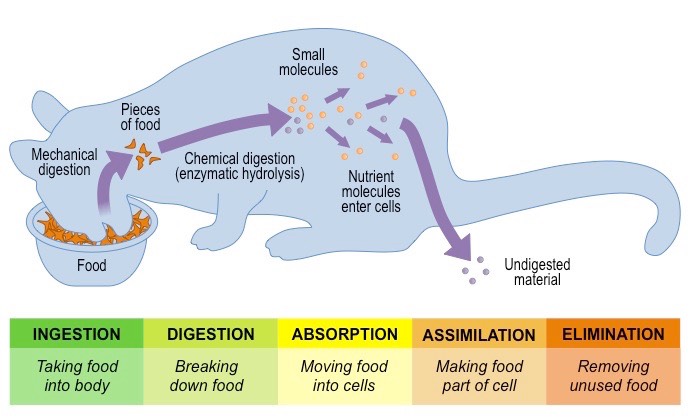
Outline the acquisition of energy and matter by mixotrophic protists.
B4.2.5: Mixotrophic nutrition in some protists.
Mixotrophs acquire energy through autotrophic and heterotrophic means.
State an example of a mixotrophic protist.
B4.2.5: Mixotrophic nutrition in some protists.
Euglena, a freshwater algae, is a mixotrophic protist.
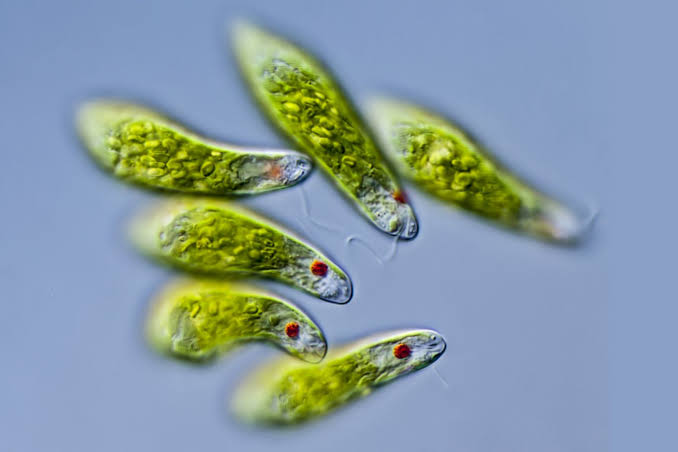
Distinguish between obligate and facultative mixotrophs.
B4.2.5: Mixotrophic nutrition in some protists.
Obligate mixotrophs require both autotrophic and heterotrophic modes of nutrition to survive.
Facultative mixotrophs can switch between the 2 modes of nutrition based on the resources available.
Euglena is an example of an obligate mixotrophs, while a Venus flytrap is an example of facultative mixotrophs.
Outline the acquisition of energy and matter of saprotrophic organisms.
B4.2.6: Saprotrophic nutrition in some fungi and bacteria
Saprotrophic organisms are heterotrophs that acquire their energy and matter from dead and decaying organisms.
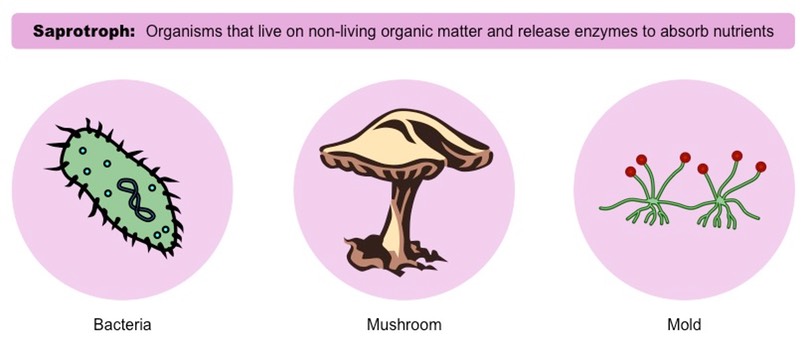
Compare digestion between decomposers and detritivore animals.
B4.2.6: Saprotrophic nutrition in some fungi and bacteria
Decomposers release enzymes to externally digest food and then absorb the nutrients. After that nutrients are absorbed. Detritivores internally digest food (with eating).
Decomposers are typically found in the top layer of the soil. Detritivores are also found in the soil, but they can even be found in marine ecosystems.
Decomposers are typically bacteria and fungi, while detritivores are animals like earthworms.
Both decomposers and detritivores are heterotrophs that consume decomposing organisms.
List two examples of saprotrophic organisms.
B4.2.6: Saprotrophic nutrition in some fungi and bacteria
Fungi
Earthworms
List the three domains of life.
B4.2.7: Diversity of nutrition in archaea.
Archaea
Bacteria
Eukaryota
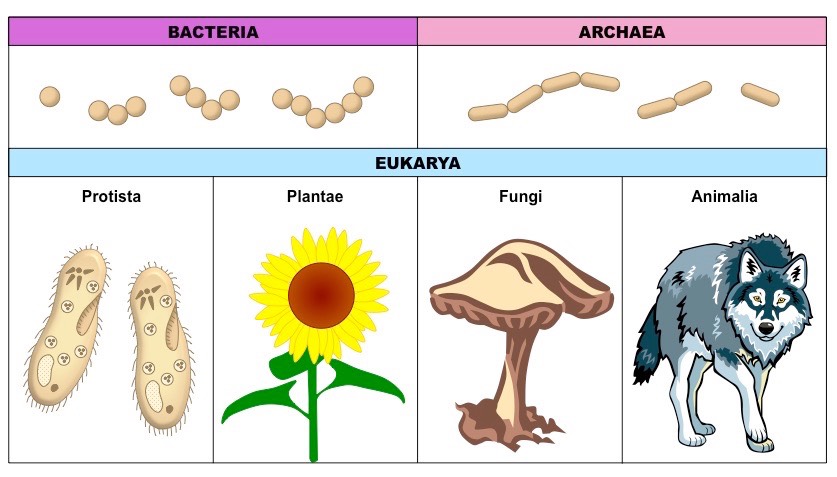
Outline the characteristics of archaea.
B4.2.7: Diversity of nutrition in archaea.
Prokaryotes
No nucleus
Extremophiles (can survive in extreme conditions)
Cell wall & histone-like proteins in DNA
Membrane lipids with branched hydrocarbons
Circular chromosomes
No nuclear envelopes
No membrane-bound organelles
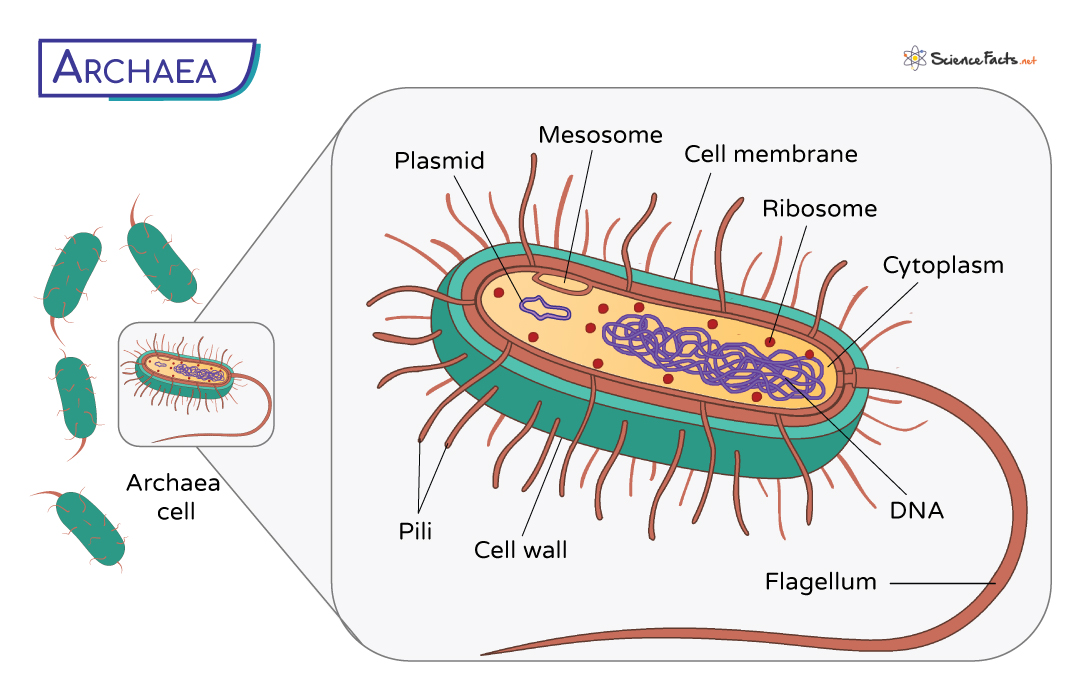
Compare the energy source and carbon source in chemoautotrophs and photoautotrophs.
B4.2.7: Diversity of nutrition in archaea.
Photoautotrophs take energy and carbon by using light energy to produce ATP (but NOT photosynthesis).
Chemoautotrophs get their energy by oxidizing hydrogen sulfide, methane, or ammonium to convert carbon dioxide into organic biomass (chemosynthesis).
Heterotrophs gain their energy and carbon from eating other organisms.

Outline how an examination of a skull model can be used to infer diet with examples.
B4.2.8: Relationship between dentition and the diet of omnivorous and herbivorous representative members of the family Hominidae.
An organism’s teeth can be used to infer their diet.
Paranthropus robustus and Homo floresiensis had large, relatively flat molars, which were probably used for grinding. Thus, they were probably herbivores.
Homo sapiens have sharp incisors (for consuming tough meat) and small flat molars (for grinding), implying that they are omnivores.
Deduce the diet of an organism given dentition patterns.
B4.2.8: Relationship between dentition and the diet of omnivorous and herbivorous representative members of the family Hominidae.
Carnivores have large canines used to hunt.
Herbivores have flatter molars for grinding.
Omnivores have both sharp incisors and flat molars.
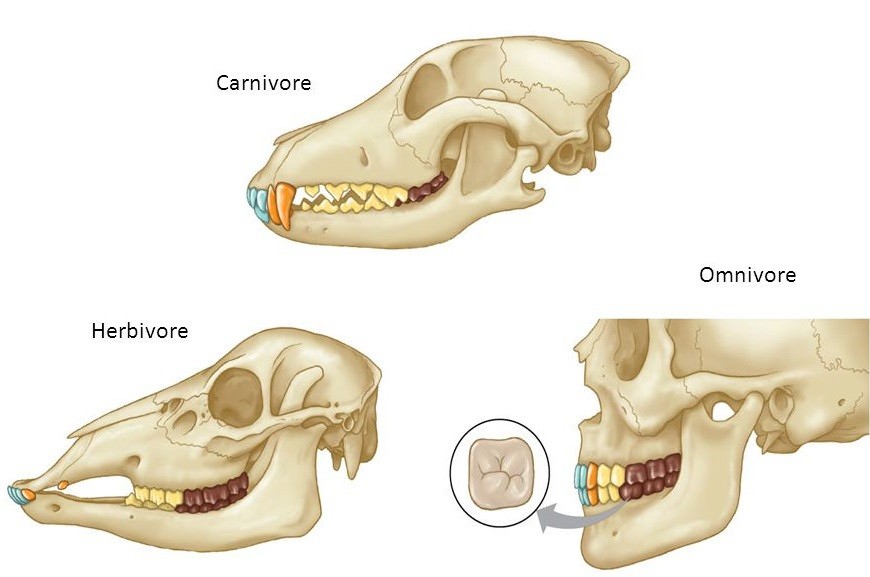
Outline the physiological, morphological, and/or behavioral adaptations of leaf-eating insects for feeding on plants.
B4.2.9: Adaptations of herbivores for feeding on plants and of plants for resisting herbivory.
Leaf-eating insects have sharp mandibles that cut through the cell walls of leaves in plants. They also have strong muscles to manipulate these mandibles. Grasshoppers and caterpillars have mandibles.
Some insects like aphids have stylets, which are hollow slender tubes that can insert directly into the phloem of plants to obtain the nutrients in the phloem.
Outline the physiological, morphological, and/or behavioral adaptations of herbivorous vertebrates for feeding on plants.
B4.2.9: Adaptations of herbivores for feeding on plants and of plants for resisting herbivory.
Some grazing mammals have broad, flat molars to grind grass. Additionally, their teeth may continue to grow throughout their life so that it doesn’t become worm down.
Cows swallow grass or hay before fully chewing it, regurgitates it, and then chews the curd (ruminants). Their digestive systems are adapted this way to be able to digest the tough grass.
Outline the physiological, morphological, and/or behavioral adaptations of plants for resisting herbivory.
B4.2.9: Adaptations of herbivores for feeding on plants and of plants for resisting herbivory.
Plants have physical structures like thorns or tough fibrous leaves to resist herbivory (morphologically).
Some plants also produce chemicals in plants or leaves to deter herbivores from eating them.
For instance, stinging nettles have sharp trichomes with irritating chemicals.
Chili plants produce capsaicin in fruits and seeds, causing a burning sensation in the digestive system.
However, not all animals are affected. Some birds and animals are not deterred.
Tobacco plants produce the toxin nicotine.
However, the caterpillars of the tobacco hawk moth (tobacco hornworm) have evolved to detoxify nicotine so that they can feed on the tobacco plant.
Outline the chemical, physical, and/or behavioral adaptations of predators for finding, catching, and killing prey.
B4.2.10: Adaptations of predators for finding, catching, and killing prey and of prey animals for resisting predation.
Chemical Adaptations
Neurotoxins in bite
E.g. the Black Mamba (Dendroapis polylepis) from southern & eastern Asia, which bites and injects its venom (to paralyze prey), waits until its victim no longer moves, then ingests its prey whole.
Produce chemicals mimicking pheromones (organic molecules sending messages through the air) to attract prey
The orb-weaver spider produces chemicals mimicking moths’ sex pheromones. The moths are attracted to the spiders, only to be eaten.
Physical Adaptations
Excellent eyesight
Birds of prey (hawks, eagles) have very excellent, accurate eyesight
Owls are adapted for seeing in low light at night
Echolocation: Sending ultrasonic vibrations so that the brain can process how waves bounce off objects (including prey) to perceive its environment with sound
Bats & dolphins use echolocation to hunt
Electromagnetic fields used to detect prey
Sharks have adapted organs in their heads (ampullae of Lorenzini) that can detect changes in electromagnetic fields. The nervous systems of their prey release small discharges of electricity that are detected by sharks.
Strong sense of smell
Birds like vultures can find rotting flesh
Fish can find prey in low-light conditions
Ability to fly, run, or swim rapidly or precisely to chase down prey
Claws, beaks, teeth, and an adapted digestive system is used to kill prey and extract nutrients
A brain that can rapidly assess changing circumstances and make complex decisions involving time, energy, and risk
If the risk of exhaustion or injury is too great, the predator needs to know it needs to give up.
Behavioral Adaptations
Ambush predators hide and wait for their prey to come near and then pounce on them
Spiders build a web
Angler fish hide on the ocean floor, use their illicium (long thin appendage) as a lure to attract prey, and then open their mouths to engulf their prey
Pack hunting: Teamwork increases the chances of bringing down a large animal
Wolf species hung in packs where there is trust and one animal is the leader
Hymenoptera (ants, termites, bees, wasps)
Soldier ants raid and use their mandibles to kill and dismember their prey and then bring the dead prey back to the colony
Pursuit Predator: Relies on speed to outrun its prey
Cheetahs are well-adapted to chase down gazelles, as they are the fastest land mammal over short distances
Persistence Hunting: The predators keep pursuing their prey for many hours until it drops from fatigue
Humans as hunter gatherers were persistence hunters
Outline the chemical, physical, and/or behavioral adaptations of prey animals for resisting predation
B4.2.10: Adaptations of predators for finding, catching, and killing prey and of prey animals for resisting predation.
Chemical Adaptations
Produce chemicals that taste bad or poison the predator
Poisonous dart frog (Phyllobates terribilis) produces alkaloid on skin, which interferes with the muscle function (including heart muscles) of predators, killing the predator.
Physical Adaptations
Camouflage: An animal can take on the appearance of its surroundings to fool predators that rely on vision
Moths have a single coloration pattern (ONE fixed adaptation)
Octopus can modify their skin cells to adapt to the colors and textures of the background (ADAPTING to the environment)
Aposematism: An animal can use dramatically bright and unusual colors to warn potential predators they are poisonous
Non-venemous kingsnakes look like poisonous coral snakes
Some animals send warning vocalizations to deter predators and warn fellow prey there is danger
Birds like jays and blackbirds or primates
Protective shells
Invertebrates have exoskeletons (grasshoppers, lobsters)
Hard shells (clams, mussels, turtles, tortoises)
Sharp spines (porcupines)
Behavioral Adaptations
Large groups: Animals may group together because a large group will have fewer kills than solitary individuals or small groups
A herd of elephants will have largest adults outwards and the young in the center so that predators are dissuaded from attacking a group because the risk of getting injured is greater than the chance of taking on a vulnerable, solitary juvenile
Wildebeests
Describe examples of adaptations for harvesting light, including height, lianas, epiphyte, shade-tolerance, and leaf surface area.
B4.2.11: Adaptations of plant form for harvesting light.
Leaves need as much sunlight as possible to photosynthesize.
Trees have height as their advantage. They have sturdy wooden trunks that allow them to invest energy and nutrients in order to grow tall and dominate the canopy. This way they can position leaves above the ground and above the competitors.
Lianas are vines that take root on the forest floor and use trees as a scaffold so that they can grow into the canopy to obtain more light. They can’t build big enough trees to reach the canopy, so they seek out the shade (where trees are) and climb up on them. They are directly in competition for resources with trees, so much so that it can eventually kill a tree.
Epiphytes, similar to lianas, grow on the surface of a tree to attain moisture (like moss or orchids). They attain moisture from water trickling down a branch when it rains or from humidity. They attach their roots to tree trunks and can survive with little water. Hemi-epiphytes spend their early life in a tree, but push their stems upwards to reach sunlight AND downward to reach the ground and grow roots.
Shade-tolerant shrubs grow on the forest floor. They are adapted to absorb wavelengths of diffused sunlight and longer (more red) wavelengths. These plants typically include herbaceous plants (herbs) that do not produce a woody stem with bark. Leaves in the understory grow large broad leaves to absorb as much light as possible.